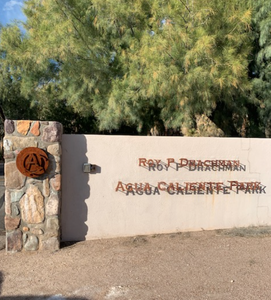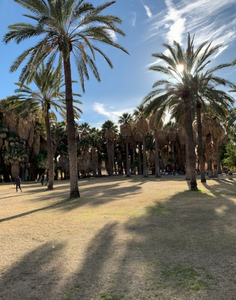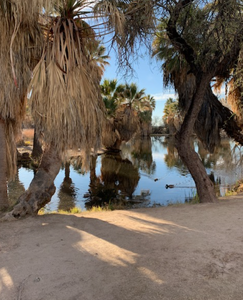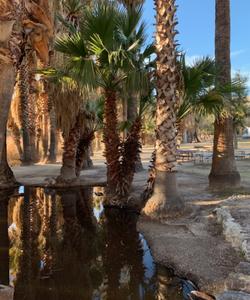Agua Caliente Park is a 101-acre park located in the desert of Tucson, Arizona. Agua Caliente which means "hot water", features a perennial hot spring, and three ponds. The park is a historical landmark that has been around for over five thousand years. Surrounded by the Sonoran Desert, Agua Caliente has a backdrop of the Santa Catalina and Rincon Mountains. Signs throughout the park outline the diverse habitats, Fuller's Orchard, restoration plans, history of the park, and even a list of bird's you can find for each month. The surprisingly large body of water supplements a diverse wildlife scene and lush vegetation such as: large palm trees, fully mature Mesquite trees, and wide open grass areas.
Address:
12325 East Roger Road
Tucson, AZ 85749
Hours:
7:00 a.m. to Sunset every day
History
From 1850-1870 the park was used as a Periodic Army Troop encampment and bought with the Gadsden Purchase. The park became a stagecoach stop, which is how the 150-year-old palm trees came to inhabit the park. In 1875 Agua Caliente was bought by James P. Fuller who created the "Fuller Springs Health Spa". James Fuller also put in orchards and built an adobe house with one-room. From 1885 to 1951 the park was bought by various owners who changed the "Health Spa" to a cattle ranch, horse ranch, and hay farm. Art Filiatrault then bought the ranch in 1951 and increased the acreage to 1200. In 1984 Agua Caliente was purchased by Pima County Parks and Recreation of 101 acres, for $1, 461, 335. Roy P. Drachman's name is featured on the park because he donated $200,000 to help with the purchase of 1984.Pima County opened Agua Caliente Park on January 19th, 1985. Lastly, Agua Caliente Ranch was listed in the National Register of Historic Places on July 9th, 2009.
Modern improvements have been done to make the park more comfortable and easier to navigate for visitors. However, these changes have kept the historical charm that the park has to offer. Maps and interpretive signs are one of the many additions made to the park. The Ranch House (which was built in the 1920s ), now known as Rose Cottage has been restored. Today, Rose Cottage is used as an education center that is open occasionally to help inform people of the surrounding environment of Agua Caliente Park. The Ranch House has also been restored while still holding true to the original time period in which it was built. The Ranch House features a gallery and Audubon nature shop.
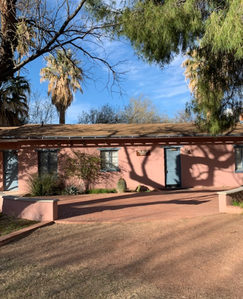 Rose Cottage Education Center
Rose Cottage Education Center  Ranch House
Ranch House
Amenities/Features
Agua Caliente Park offers large grass areas, picnic spots with grills and tables, paved walking paths, hiking trails, restrooms, and drinking water. The park offers different art exhibits and activities throughout the year that are listed onhttp://www.friendsofaguacaliente.org/events.htm. The entrance to the park is a paved road with many parking spaces that face the main grass area. The large open grass area is a great place to have picnics and enjoy outdoor activities. Visitors of Agua Caliente can be seen playing soccer, playing with their dogs, taking pictures, and picnicking. There are three ponds at Agua Caliente Park, two of which still have water in them. The historic pond does not retain any natural spring water anymore, but visitors can take a scenic trail/walk to visit the pond. There are beautiful Sonoran Desert plants, and other wildlife that visitors can enjoy along the way. While walking some of the trails visitors may come across the famous "Fuller's Orchard". The largest of the three ponds, which is what visitors first see upon entering the park, is filled with water year round. And the second pond located on the North West section of the park has seasonal water flow. The park can be used for weddings, reunions, picnics, and other gatherings on prior approval, and reservation.
Diverse Wildlife
The best time to see a flourish of wildlife is during in the cooler parts of the year. Due to the natural water, Agua Caliente Park is a hot spot to witness native and non-native wildlife. Visitors can interact and view wildlife in a natural setting. In the ponds, there is an accumulation of non-native fish. On any given day visitors could see tilapia, bluegill, bass, coy fish, or grass carp. There is also a surprisingly large turtle population in the park. Visitors can always see turtles swimming around, laying out on the various floating logs, or bathing in the sun on the secluded island located in the middle of the largest pond. In the mesquite woodland parts of the park animals such as: mule deer, bobcats, and Abert's towhees might be hiding about. Animals such as: javelinas, black-tailed jackrabbits, cactus wrens, and curve-billed thrashers can be found in the scrub habitat of the park.
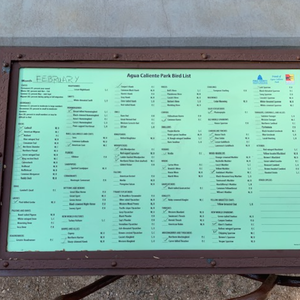 There is also a great variety of birds that can be seen flying around, and enjoying the cool ponds. The list of birds that have been documented to visit, and resided, in Agua Caliente Park is long. There are over thirty species of birds, and numerous sub-species, whose residence ranges from being common to rare, and whose status is either permanent or seasonal. The best way to enjoy these beautiful creatures is to bring some binoculars and sunglasses.
There is also a great variety of birds that can be seen flying around, and enjoying the cool ponds. The list of birds that have been documented to visit, and resided, in Agua Caliente Park is long. There are over thirty species of birds, and numerous sub-species, whose residence ranges from being common to rare, and whose status is either permanent or seasonal. The best way to enjoy these beautiful creatures is to bring some binoculars and sunglasses.
Agua Caliente Park Toady
Unfortunately, in the summer of 2004, the main pond experienced a devastating dry season that all but dried up the entire pond. The reason the pond almost dried out entirely was the result of several years of droughts, and the inability of the hot-springs to supply water to the ponds and several smaller ponds at the park. Despite this scary incident, there were several recovery factors that were put into action to ensure Agua Caliente Park would continue to be an enjoyment to the surrounding community, and attract visitors. First, there has been an increase in the amount of rainfall Tucson has been getting, which aids in the fluctuation of the natural water supply. Second, there has been a renegotiation of well to well transfer, and as a result, Agua Caliente Park can pump more water into the ponds in less amount of time. Lastly, there has been a new pump installed into the pond to create a more efficient method of subtracting water from the ground. Not only does the increase in the amount of water supply to the pond important to attract visitors, but it’s crucial for the surrounding wildlife, who depend on the water supply the ponds emit.
As of now (2019), The main pond is not currently sustainable. In March of 2019, the pond will go through a restoration. Thousands to hundreds of thousands of gallons of well water are being pumped every day. The pond restoration will keep most of the resembleth of the current state with respect to the vegetation. Some new changes are that there will be an addition of a bridge and the pond will be much deeper. The fish and other wildlife that lives in the pond will be relocated or removed. The Park will be closed for a few weeks during restoration. For more information on the restoration visit http://webcms.pima.gov/cms/one.aspx?portalId=169&pageId=1503
References:
http://webcms.pima.gov/cms/one.aspx?pageId=1503&portalId=169
http://www.friendsofaguacaliente.org/index.htm

